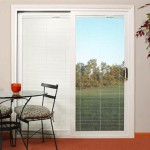Patio Door Air Conditioner Vent: A Comprehensive Guide
The efficient ventilation of portable air conditioners is paramount for optimal cooling performance and energy efficiency. When a window is unavailable or unsuitable, a patio door air conditioner vent emerges as a viable alternative. These vents, designed to be installed within the frame of a sliding patio door, facilitate the expulsion of hot air generated by the air conditioning unit. This article explores various types of patio door air conditioner vents, installation methods, and considerations for maximizing their effectiveness.
Unlike window air conditioners that are self-contained and exhaust directly to the outside, portable air conditioners require a duct to vent the hot air produced during the cooling process. Without proper venting, this hot air recirculates within the room, substantially reducing the unit's cooling capacity and increasing energy consumption. Patio door vents provide a pathway for this hot air to exit the dwelling, maintaining the desired indoor temperature.
Types of Patio Door Air Conditioner Vents
Patio door air conditioner vents are available in a range of designs and materials, each with its own set of advantages and disadvantages. Choosing the appropriate type depends on factors such as the size of the patio door, the type of sliding mechanism, and aesthetic preferences.
1. Sliding Panel Kits: These kits consist of adjustable panels that are inserted into the open portion of the patio door. The panel typically features a cutout to accommodate the air conditioner's exhaust hose. Sliding panel kits are often constructed from durable materials such as acrylic or PVC. They offer a relatively easy installation process, requiring minimal tools and expertise. The adjustability of the panels allows them to fit a variety of patio door widths.
The primary advantage of sliding panel kits lies in their versatility. They can be easily removed and reinstalled, making them a convenient option for seasonal use. Moreover, they provide a relatively airtight seal, minimizing air leakage and preventing the entry of insects or drafts. However, the aesthetic appeal may be a concern for some homeowners, as the panels can obstruct the view and alter the appearance of the patio door.
2. Fabric or Vinyl Window Seals: These seals are designed to create a barrier around the air conditioner hose where it exits the patio door. They typically consist of a fabric or vinyl cover that attaches to the door frame and the air conditioner hose using zippers or Velcro. While less rigid than sliding panel kits, fabric or vinyl window seals offer a more flexible and often more affordable solution.
One of the key benefits of fabric or vinyl window seals is their ease of installation. They require no cutting or permanent modifications to the patio door. Furthermore, they can be easily stored when not in use, taking up minimal space. However, these seals may not provide as airtight a seal as sliding panel kits, potentially leading to air leakage and reduced cooling efficiency. Their durability may also be a concern, as the fabric or vinyl material can be susceptible to wear and tear.
3. Custom-Built Vents: For homeowners seeking a more customized and aesthetically pleasing solution, custom-built vents offer a viable option. These vents can be constructed from a variety of materials, such as wood, acrylic, or metal, and can be designed to seamlessly integrate with the existing patio door. Custom-built vents often involve more complex installation procedures and may require professional assistance. However, they provide a tailored fit and can be designed to meet specific aesthetic requirements.
The main advantage of custom-built vents is their ability to match the style and décor of the home. They can be painted or stained to blend in with the existing patio door frame, minimizing their visual impact. Moreover, they can be designed to provide a secure and airtight seal, maximizing cooling efficiency. However, the higher cost and complexity of installation are significant considerations.
4. Inflatable Window Seals: An inflatable window seal provides an airtight barrier around the air conditioner hose where it exits the patio door. This type of seal is made from a durable, inflatable material that fits snugly within the opening of the door. It uses a simple inflation system, often a small hand pump, to expand the seal and create a tight fit.
The primary advantage of inflatable seals is their ease of installation and adjustability. They are very easy to install and remove, requiring no tools or special skills. The seal can be quickly adjusted to fit different hose sizes and door heights, making it a versatile option. It also offers good portability and can be easily stored away when not in use. However, depending on the quality, it may not be as aesthetically pleasing as some other options.
Installing a Patio Door Air Conditioner Vent
The installation process for a patio door air conditioner vent varies depending on the type of vent chosen. However, some general principles apply to most installations.
1. Preparation: Before beginning the installation process, it is essential to gather the necessary tools and materials. This may include a measuring tape, screwdriver, saw (depending on the type of vent), sealant, and safety glasses. Cleaning the patio door frame and surrounding area is crucial to ensure proper adhesion and a secure fit.
2. Measurement: Accurately measuring the opening of the patio door is critical for selecting the appropriate size vent. Measure the height and width of the open portion of the door, taking into account any obstructions or irregularities in the frame. For sliding panel kits, ensure that the panels are adjustable enough to fit the measured dimensions.
3. Installation: Follow the manufacturer's instructions carefully when installing the vent. For sliding panel kits, insert the panels into the open portion of the door and adjust them to fit snugly within the frame. Secure the panels with screws or clips, ensuring that they are properly aligned. For fabric or vinyl window seals, attach the seal to the door frame and the air conditioner hose using zippers or Velcro. Ensure that the seal is taut and that there are no gaps or openings.
4. Sealing: To prevent air leakage, apply sealant around the edges of the vent and the air conditioner hose. This will create an airtight barrier, maximizing cooling efficiency and preventing the entry of drafts or insects. Choose a sealant that is compatible with the materials of the vent and the patio door frame.
5. Testing: After installation, test the air conditioner to ensure that the vent is functioning properly. Check for any air leaks and make any necessary adjustments to improve the seal. Monitor the indoor temperature to verify that the air conditioner is effectively cooling the room.
Considerations for Maximizing Vent Effectiveness
To ensure optimal performance of a patio door air conditioner vent, several factors should be taken into consideration.
1. Air Sealing: One of the most important considerations is air sealing. A poorly sealed vent can negate the benefits of the air conditioner by allowing hot air to enter the room. Inspect the vent regularly for any gaps or openings and apply sealant as needed. Consider using weather stripping around the edges of the vent to further improve the seal.
2. Hose Length and Diameter: The length and diameter of the air conditioner's exhaust hose can also affect its performance. A longer hose will increase the resistance to airflow, reducing the unit's cooling capacity. Similarly, a hose that is too narrow will restrict airflow. Use the shortest possible hose length and ensure that the diameter of the hose is appropriate for the air conditioner.
3. Placement of the Air Conditioner: The placement of the air conditioner in relation to the patio door vent can also impact its effectiveness. Position the air conditioner as close as possible to the vent to minimize the length of the exhaust hose. Avoid placing the air conditioner in direct sunlight, as this can increase its energy consumption. Ensure that the air conditioner has adequate clearance around it to allow for proper airflow.
4. Insulation: Insulating the patio door vent can further enhance its performance by reducing heat transfer. Apply insulation to the exterior of the vent to prevent heat from entering the room during hot weather. This will reduce the load on the air conditioner and improve its energy efficiency. Consider using reflective insulation to further minimize heat transfer.
5. Maintenance: Regular maintenance is essential for ensuring the longevity and effectiveness of the patio door air conditioner vent. Clean the vent regularly to remove dust and debris that can obstruct airflow. Inspect the vent for any signs of damage or wear and tear and make any necessary repairs. Replace the sealant as needed to maintain an airtight seal.
6. Safety: Always prioritize safety when installing and using a patio door air conditioner vent. Ensure that the vent is securely attached to the patio door frame to prevent it from falling or causing injury. Avoid blocking the vent with furniture or other objects that could restrict airflow. Follow all safety precautions outlined in the air conditioner's user manual.
7. Material Selection: When selecting a patio door vent, consider the material's durability and resistance to weather. Opt for materials that withstand sun exposure, rain, and temperature fluctuations. PVC, acrylic, and aluminum are common choices known for their weather resistance. Consider the color and finish as well to ensure it complements the existing aesthetics of the patio door.
8. Compatibility with Door Type: Ensure the vent is compatible with the type of sliding door. Some vents are designed specifically for horizontally sliding doors, while others can be adapted for vertically sliding doors. Check the specifications and compatibility notes before purchase to avoid installation issues. Correct sizing is vital for effective performance.
By taking these factors into consideration, homeowners can maximize the effectiveness of their patio door air conditioner vents and enjoy a comfortable and energy-efficient cooling experience. Selecting the right type of vent, installing it properly, and maintaining it regularly are all essential for achieving optimal performance.

How To Install Portable Ac In A Slide Door Step By

Custom Balcony Sliding Door Seal For Portable Air Conditioner Exhaust Pipe Youtube

Portable Air Conditioner Window Kit Sliding Door Vent Wi Mercadolivre

Custom Portable Ac Window Kit For Sliding Martinson Manufacturing

Custom Ac Window Vent For Casement Sliding Windows

Portable Air Conditioner Window Vent Kit Apack5 The Home

7 Times A Portable Air Conditioner Makes Sense Over Window Ac Wirecutter

Custom Ac Window Vent For Casement Sliding Windows

Portable Air Conditioner Window Vent Kit Apack5 The Home

How To Install A Portable Air Conditioner 10 Steps








